Content-aware video/image quality assessment
Here you can find the algorithm (Matlab file [M-File]) tested in the work Benhur Ortiz-Jaramillo, Jorge Niño-Castañeda, Ljiljana Platisa, Wilfried Philips, "Content-aware objective video quality assessment", Journal of Electronic Imaging 2016. Please reference this work if you use any of the code available in this page. To download the files, please navigate to the links below. For the login information (user name and password) please contact Benhur Ortiz Jaramillo indicating the purpose of using this code.
Context
The amount of collected data for video based applications has increased dramatically in the recent years due to the massive use of video-based systems such as surveillance, broadcasting, product inspection, among others. The huge quantity of videos requires a great number of storage devices and consequently the storage cost may be extremely expensive. Video compression is used to reduce the storage cost by reducing the video storage size without affecting the “user satisfaction”. Thus, compression parameters should be selected based on visual assessment (trying to mimic the visual system). Hence, quality control of video-based systems is a very important task for reducing the storage size by keeping the “user satisfaction”.
The existing objective methods are computationally too complex and/or not generic enough for a wide variety of video content scenes. The latter problem is mainly due to the strong dependency of video quality on the video content. The proposed method performs video quality assessment between two video sequences (a reference and compressed sequence).
Why does video content matter?
Example Sequences 1, 2, 3 differ in Perceived Video Quality: 71%, 54%, 32% yet their estimated values are the same (SOVQM*: 0.5)! *The National Telecommunications and Information Administration (NTIA)
Our Solution: Video quality testing (Matlab file [M-File])
CPSNR is competitive with the state-of-the-art (80% correlation with subjective scores) but it is faster and simpler (See Ref).
Our solution: quality aware video compression
Purpose
Identify those frames of the video which are of "needlessly high quality" and increase the quantization value as long as the perceived quality stays “the same” (i.e. above the given threshold)
CPSNR quality-controlled h.264 video encoding brings bitrate savings of 10-37% and archive file size reduction of 30-40% while maintaining the PVQ approximately the same as uncompressed [imec Tecnology forum].
Example of quality aware video compression. Left side: video codec using recommended encoding settings for that resolution. Right side: video codec using quality aware video compression. Note that there is a considerable bit rate saving (green bar).


